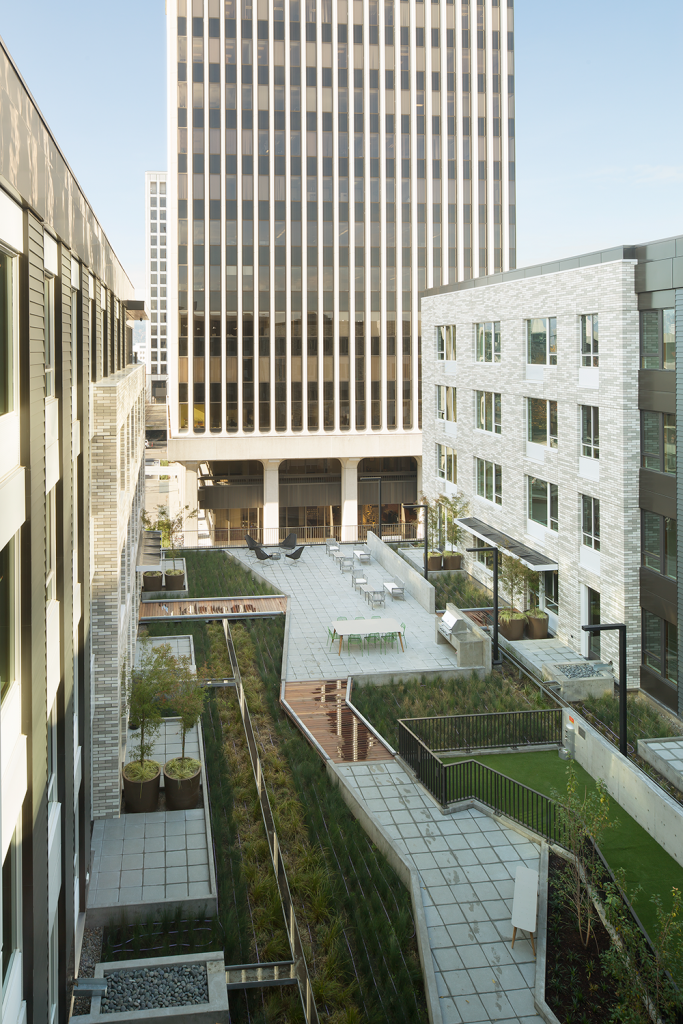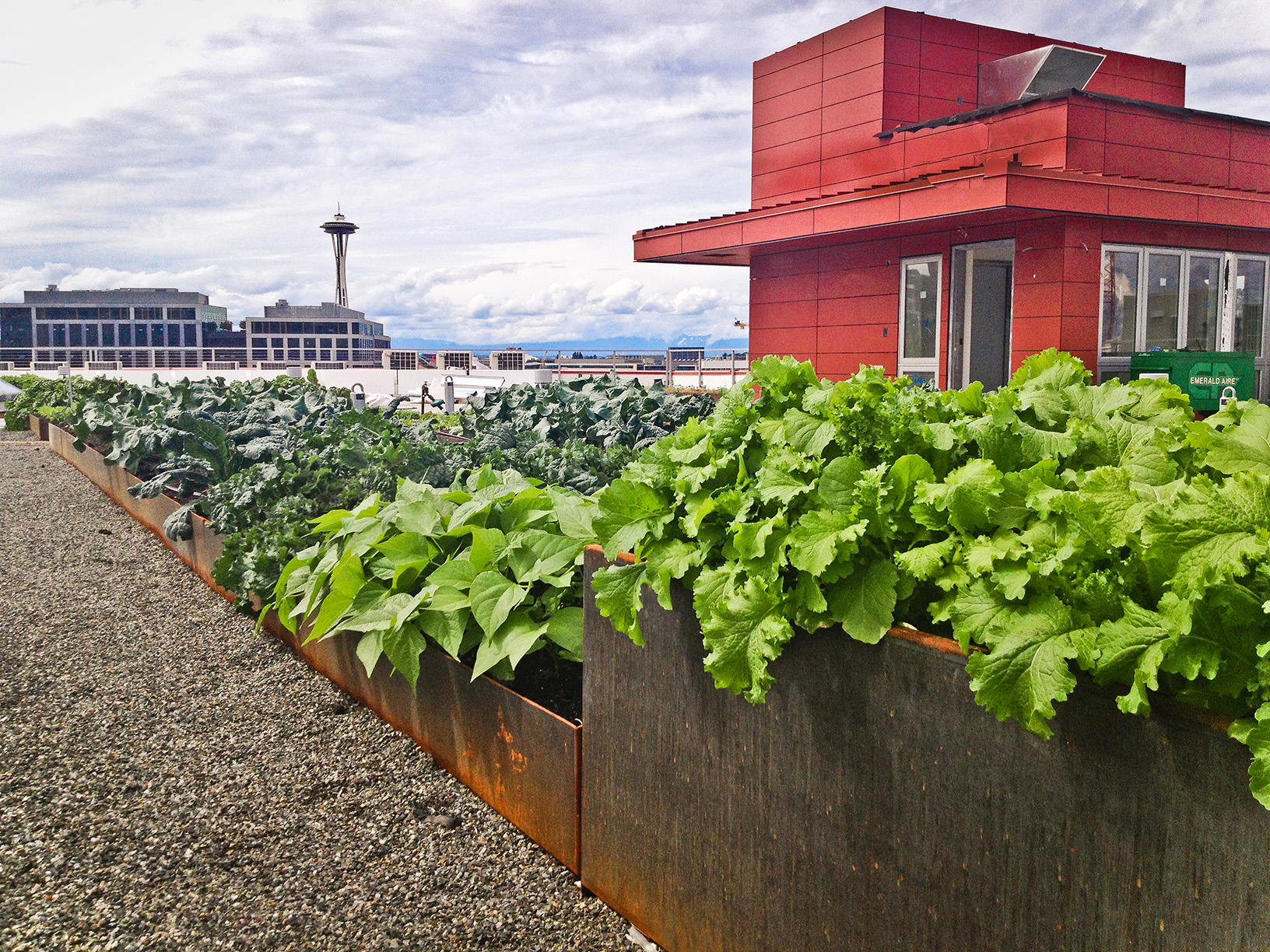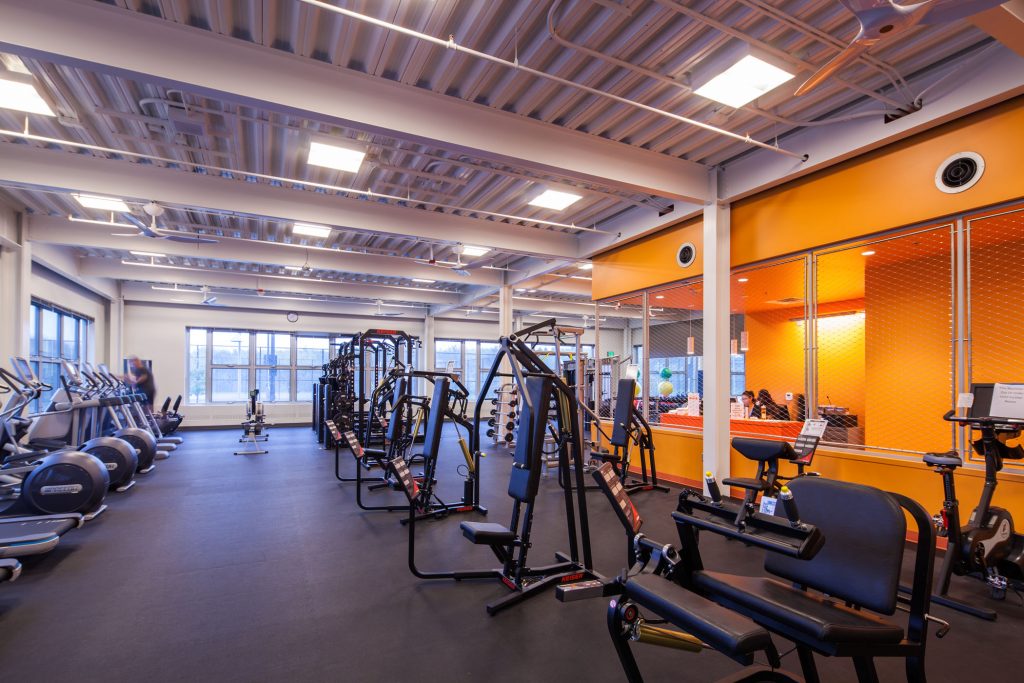Rethinking High Performance Buildings
Cover photo: University of Washington Bothell Activities and Recreation Center; LMN Architects. The University of Washington Bothell Activities and recreation Center uses no mechanical cooling.
Resiliency and health are broadening our thinking around high performance building, and Biophilia is a design tool for incorporating both and working to mitigate the effects of climate change.
When the sustainable design community discusses resilient buildings, the dialogue is often couched in phrases like “onsite energy independence,” “future-proofing,” and “community readiness.”
Yet, as we’ve learned from the increasing incidence of traumatic climate-related events, resiliency goes beyond keeping buildings upright and lights on. We have seen (and some of us may have unfortunately experienced) the consequences of severe wildfires, flooding, and storms that in 2017 alone cost the U.S. economy $312.7 billion dollars (NOAA 2017) in property and infrastructure damage, business disruption, and community displacement. More often the causes of these events arise from atypical conditions—draught and unusual weather—that collide with the seasons, sparking wildfires and unleashing tornadoes, hurricanes, dangerous winter weather and flooding. When the power goes out, the water isn’t safe to drink, and people can’t go anywhere, the risks and costs to businesses escalate minute by minute. Those repercussions aren’t limited to the communities affected. The media stories of the physical and mental stress the communities endure are felt globally, and the resulting emotions effect our daily lives, interfering with our relationships and hampering our productivity.
The frequency and intensity of weather-related events is growing. This is true, despite global and local efforts to reduce greenhouse gas emissions, which largely stem from fossil fuel use, as well as the more recent spotlight on meat consumption and food waste.
With all this happening and our knowledge of our impacts to the planet, it seems we need to re-evaluate our efforts in the building industry and rethink “high performance.”
Resiliency as an Indicator of High Performance Building
When we think of high performance buildings, the building industry has traditionally equated this term to something akin to “smart resource use,” and “energy efficiency” most often comes to mind because reducing fossil fuel use is the primary goal.
But is a building “high performance” if the basement floods and the electrical supply is submerged? If the power goes out for days, and there is not a single outlet to charge a cell phone or power a radio for communication? With these “strange weather” occurrences becoming more prevalent (and severe in damage), we can’t wait for building codes to catch up to prepare building occupants for what may come. A longer-term perspective to design that encompasses resilience should be the new paradigm for high performance buildings.
These events are largely dependent on region. In the Pacific Northwest, for example, predicted earthquakes, and to some extent flooding, are two very real threats to infrastructure. As a result, we are now working to design some buildings to IBC Risk Category IV standards to ensure continued operation and employee safety in the event of a threat. To achieve this, critical equipment is shaker-table-tested, meaning the equipment is designed for continued operation through an earthquake, allowing a building to remain operational. Through the design process, we find means to improve the energy-efficiency of building systems. They can perform better under such rigorous testing, meaning energy efficiency doesn’t necessarily have to come at an additional cost. Regarding flood protection, critical systems such as generators and all the back-up electrical systems are located on the roof and all critical infrastructure is located on or above the second floor.
Health as an Indicator of High Performance Building
Central to the premise of resilient buildings is their ability to respond to environmental shocks and keep people safe. Ensuring occupant safety and survival is the most immediate and important human need for all occupied buildings.
The secondary need is for people to feel satisfied in the buildings they occupy. Resilience plays a role here too. You may have heard the catch phrase “high performance people.” It explains resiliency at the human level and how the indoor environment plays a large role in supporting occupant health and wellbeing. After all, today we spend upward of 90% of our time indoors.
A building that offers daylight, safe water, nontoxic materials, and a clean and sufficient air supply can boost mental and physical health and enable the body to fend off the general stress of life. As with the case of resilient buildings, the perception of “high performance” building needs to broaden beyond efficiency to better encompass the health and wellbeing of the people inside.
The ILFI LBC Standard, USGBC LEED Building Standard, IWBI WELL Building Standard, and the Center for Active Design Fitwel Standard, are four sustainable building programs that are working to balance “high performance” design with “high performance people,” using criteria that addresses indoor occupant health and satisfaction. The LBC is the only program to address resiliency through planned building infrastructure. WELL and Fitwel stress community preparedness programs, and LEED had two resiliency-focused Pilot credits that USGBC has since closed. Created by the C3 Living Design Project (C3LB), RELi is a next-generation standard with the most focus on resilient design and is potentially becoming a think tank for the evolution of resiliency standards making their way into these four other programs.
To summarize, the theme of resiliency encompasses two spheres of influence. Both impact buildings, but the intent is on people. One is a focus on planning and designing buildings able to withstand the forces of a changing climate and keep people safe. The other focus is on designing spaces that support human health to enable people to live out their lives as best they can.
The Biophilic Design Solution
Emerging from this discussion of building and human resilience is the subject of biophilia. The innate human attraction to nature, biophilia is increasingly understood to play an important role in the built environment.
An enormous body of evidence substantiates that nature is a benefit to public health. People are quite simply healthier when they spend time outdoors. And when indoors, a combination of daylight, plants, and natural materials and patterns give visual cues that regulate the body’s hormones, so that we have more energy during the day and sleep better at night. People simply function better with access to nature. Indeed, studies find that when biophilia is a central design point, students learn better in school, employees are more productive at work, and hospital patients recover more quickly from illness. Perhaps the most amazing aspect of biophilic design is that it’s a free tool to use. Nature is free to boost human health and design inspiration in every new building, renovation, and retrofit.
The LBC, LEED, WELL, and Fitwel standards all offer credit for incorporating some level of biophilic design practice, with LBC giving greatest weight toward certification. To further the awareness of biophilic design, ILFI’s Biophilic Design Initiative (BDI) has published a book showcasing a portfolio of biophilic case studies, including Glumac’s Shanghai office. The BDI has also published a free practical guidebook and showcases an online interactive world map where project teams can submit their case studies.
Biophilic Design as a High Performance Building Tool to Mitigate the Effects of Climate Change
Biophilic design can create healthy environments indoors, and because its strategies take cues from nature, it can have the dual benefit of minimizing the effects of climate change. Buildings and communities can become more resilient and efficient by adopting biophilic design principles.
Take the example of green infrastructure. Using plant life within the built environment provides an obvious visual connection to nature and offers documented health and wellness benefits to occupants. However, this approach also provides the opportunity to mitigate against operational outages due to storms, flooding, and/or a breakdown in normal civic operations. In the event of heavy rains or flooding, green infrastructure would allow the water to seep into tree wells, rain gardens, vegetated rooftops and permeable, unpaved areas. This is far more manageable and far safer than runoff from, for example, a concrete parking lot.
Green infrastructure also minimizes urban heat islands. A heat island is an urban area that may be several degrees warmer than rural areas, largely due to paving and dark surfaces like rooftops that retain heat. Plant life provides cooling qualities that can contribute to an overall design aimed at lessening the effects of rising temperatures, creating more comfortable outdoor conditions for people, less stress on building mechanical cooling systems, and natural ventilation strategies.

The Hassalo on Eighth project turned a parking lot into an urban oasis where landscape doubles as a wastewater filtration system. Project by GBD Architects; image courtesy of Lara Swimmer
As the MEP engineer, Glumac collaborated with American Assets Trust, Turner Construction, GBD Architects, and Biohabitats to construct the Hassalo on Eighth multi-building residential development. Glumac assisted Biohabitats in the design of a waste water treatment system that can turn 54,000 gallons of sewage into reusable gray water every day, which is then used in toilet flushing, cooling, and irrigation, with any available excess used for groundwater recharge. Although a highly mechanized system, residents and visitors primarily see the abundant vegetation and hear rippling water flowing on the system’s surface. Vegetated roofs and bioswales help to control storm water across the site. With this system, residents have access and views to a diverse, natural setting, a gentle break from the harsher urban landscape, and it helps to reduce stress and mental fatigue.
Landscaping can also play a dual role in combating climate change by providing a food source. Edible gardens in urban environments provide communities an obvious, biophilic connection to nature. A local food source, edible gardens take a fraction of the carbon to produce compared to food grown, transported, and delivered to a grocery store. Glumac is working on an increasing number of projects that are integrating raised-bed gardens on building podiums and rooftops. In addition to reducing urban heat islands, these gardens provide a dependable food source in the event access to food is limited.

Garden by Berger Partnership. Rooftop vegetable gardens can offer residents a dependable food source.
Yet another biophilic climate-combatting strategy is natural ventilation from operable windows. Varied air movement prevents what UC Berkeley’s Center for the Built Environment calls “thermal boredom.” Natural air flow gives building occupants a sense of being outside, intaking fresh air—a biophilic design principle. At the same time, if a facility lost power, natural ventilation could provide urgently needed fresh air and a critical level of interior conditioning. In a more tightly sealed space conditioned by a more traditional AC system, a major outage could cause hot, stagnant air, where bacteria would spread more easily, potentially causing unsafe conditions for the occupants.
Natural ventilation was the focus of Glumac’s mechanical design for the University of Washington Bothell, Activities and Recreation Center. Glumac conducted the thermal comfort analysis, and the project team chose to incorporate natural ventilation and operable windows in the facility. This allows students to breathe fresh air, lowers the building’s carbon footprint, and saves money on cooling costs. When Glumac’s thermal comfort analyst called the facility staff to see whether the building was remaining comfortable on the hotter days, the respondent mistakenly thought the building had mechanical air conditioning and responded: “Oh yes. The students love the AC!” Clearly, the natural ventilation is providing such adequate conditioning that occupants can’t even tell the difference! And what’s more, during severe outages, the space can serve as a safe gathering point where occupants can seek shelter but remain comfortable and access adequate fresh air.
The biophilic health benefit of fresh air from lowered CO2 levels has been shown to boost student performance. Additionally, the slight changes in air movement help to stimulate the senses, invigorating energy levels. Natural ventilation can also help cramped classrooms feel larger, which can relieve stress so that students can focus their attention toward learning.

University of Washington Bothell Activities and Recreation Center; LMN Architects. The University of Washington Bothell Activities and recreation Center uses no mechanical cooling.
Natural ventilation is an effective strategy when outdoor air is clean and healthy and there is minimal threat of regular, disruptive outdoor noise levels. Daylight can also reduce electric lighting costs during the day. From the biophilic perspective, more than 50 studies have shown that natural daylight and views to nature accelerate healing rates in hospital patients, while reducing stress on patients, staff and visitors. In the event of a power loss, natural light allows building occupants to navigate through the building toward exits or safer places of shelter.
A less obvious example of biophilic design as a climate change solution is rainwater harvesting. Rainwater harvesting can mitigate strain on civic infrastructure in the event of a high-intensity storm, and it provides an additional source of water in the event of a plumbing breakdown. The connection people feel when they see a cistern is not as apparent as, say, a nature-scape, but it does indirectly connect people to weather and the seasons. The presence and sound of water has been shown to be one of the most calming sounds in nature. No wonder fountains are often displayed, large and small, in public waiting rooms and places of congregation.
Perhaps the strongest biophilic benefit to communities are parks and gardens. Be it a building’s green roof or a neighborhood dog park, outdoor spaces provide communities a place to catch a breeze, smell the air, view greenery, and hear the sound of water. When people visit these locations, they also meet fellow community members, which is one of the strongest aspects of resiliency. A strong community where people know their neighbors, share resources, and offer protection in times of need in the event of a disaster are critical to resiliency.
Renewed Collaboration
Sustainable building advocates are blessed with a pool of experts who encourage the influx of new people and fresh ideas. These experts see the need for big-picture thinking in climate science and public health in order to assist in the selection of strategies that aim for a long-term focus on building resilience, resource use, and occupant health. This is the continued evolution and journey we must take as we continue to evolve our understanding of the built environment. As we find solutions to adapt to climate change, the real opportunity for impact will come from better integrating the many layers of sustainability, human health and wellbeing, and resiliency into a true High Performance Building.
Contributors to this article were Elena Velkov, Glumac Marketing Specialist in the Seattle Market, and Alex Baumgardner, Glumac Corporate Marketing Communications Manager.



